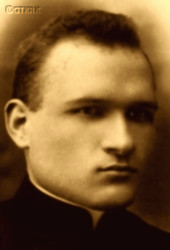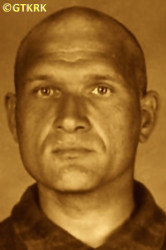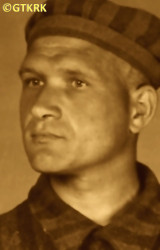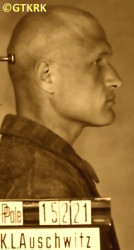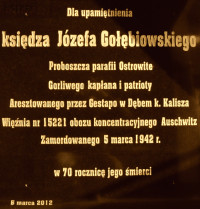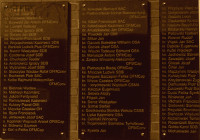Roman Catholic
St Sigismund parish
05-507 Słomczyn
85 Wiślana Str.
Konstancin deanery
Warsaw archdiocese, Poland
full list:
displayClick to display full list

searchClick to search full list by categories
wyświetlKliknij by wyświetlić pełną listę po polsku

szukajKliknij by przeszukać listę wg kategorii po polsku

Martyrology of the clergy — Poland
XX century (1914 – 1989)
personal data
surname
GOŁĘBIOWSKI
surname
versions/aliases
GOŁĘBIEWSKI
forename(s)
Joseph (pl. Józef)
function
diocesan priest
creed
Latin (Roman Catholic) Church RCmore on
en.wikipedia.org
[access: 2014.09.21]
diocese / province
Włocławek diocesemore on
en.wikipedia.org
[access: 2013.05.19]
honorary titles
Gold „Cross of Merit”more on
Gold „Cross of Merit”
(05.08.1938)
date and place
of death
05.03.1942

KL Auschwitzconcentration camp
today: Oświęcim, Oświęcim gm., Oświęcim pov., Lesser Poland voiv., Poland
more on
en.wikipedia.org
[access: 2022.01.09]
details of death
After German and Russian invasion in 09.1939 of Poland and start of the World War II, after start of German occupation, during arrests — in Germ. Warthegau (Eng. Greater Poland) province, set up by the Germans in German occupied Greater Poland and directly incorporated into Germany — of members of clandestine National Fighting Organization NOB (from 12.1940 in Poznań, from 02.1941 in Kalisz) arrested in 03.1941.
Held in Kalisz prison.
Finally on 02.05.1941 transported from Łódź to KL Auschwitz concentration camp where perished.
alt. details of death
The transport he was brought to KL Auschwitz prob. also included prisoners from EtG Radegast Gestapo prison.
prisoner camp's numbers
15221Click to display source page (KL AuschwitzClick to display the description)
cause of death
extermination: exhaustion and starvation
perpetrators
Germans
sites and events
KL AuschwitzClick to display the description, Regierungsbezirk KattowitzClick to display the description, EtG RadegastClick to display the description, KaliszClick to display the description, 03.1941 arrests (Kalisz)Click to display the description, Reichsgau WarthelandClick to display the description, Ribbentrop‐MolotovClick to display the description, Pius XI's encyclicalsClick to display the description
date and place
of birth
02.04.1902Birth certification on:
www.genealogiawarchiwach.pl
[access: 2025.09.08]

Brzezietoday: Brześć Kujawski gm., Włocławek pov., Kuyavia‐Pomerania voiv., Poland
more on
en.wikipedia.org
[access: 2021.12.18]
parents
GOŁĘBIEWSKI Adam
🞲 ?, ? — 🕆 ?, ?

ROSZAK Sophia
🞲 ?, ? — 🕆 ?, ?
baptism
06.04.1902Birth certification on:
www.genealogiawarchiwach.pl
[access: 2025.09.08]

Wieniectoday: Brześć Kujawski gm., Włocławek pov., Kuyavia‐Pomerania voiv., Poland
more on
en.wikipedia.org
[access: 2021.12.18]
St Nicholas the Bishop and Confessor and St Stanislav Kostka RC church
presbyter (holy orders)
ordination
24.06.1928

positions held
1937 – 1941
parish priest — Dębetoday: Żelazków gm., Kalisz pov., Greater Poland voiv., Poland
more on
en.wikipedia.org
[access: 2020.12.16] ⋄ Annunciation to the Blessed Virgin Mary RC parish ⋄ North Kaliszdeanery name
today: Kalisz city pov., Greater Poland voiv., Poland
more on
en.wikipedia.org
[access: 2020.12.16] RC deanery
1934 – 1937
parish priest — Ostrowitetoday: Lipno gm., Lipno pov., Kuyavia‐Pomerania voiv., Poland
more on
en.wikipedia.org
[access: 2020.12.16] ⋄ St Matthew the Apostle RC parish ⋄ Lipnotoday: Lipno gm., Lipno pov., Kuyavia‐Pomerania voiv., Poland
more on
en.wikipedia.org
[access: 2020.11.01] RC deanery
1934
parish priest — Wielgietoday: Wielgie gm., Lipno pov., Kuyavia‐Pomerania voiv., Poland
more on
en.wikipedia.org
[access: 2020.12.16] ⋄ St Lawrence the Deacon and Martyr RC parish ⋄ Lipnotoday: Lipno gm., Lipno pov., Kuyavia‐Pomerania voiv., Poland
more on
en.wikipedia.org
[access: 2020.11.01] RC deanery
c. 1934
administrator — Włocławektoday: Włocławek city pov., Kuyavia‐Pomerania voiv., Poland
more on
en.wikipedia.org
[access: 2021.12.18] ⋄ St John the Baptist RC parish (main parish) ⋄ Włocławektoday: Włocławek city pov., Kuyavia‐Pomerania voiv., Poland
more on
en.wikipedia.org
[access: 2021.12.18] RC deanery
1931 – 1934
vicar — Włocławektoday: Włocławek city pov., Kuyavia‐Pomerania voiv., Poland
more on
en.wikipedia.org
[access: 2021.12.18] ⋄ St John the Baptist RC parish (main parish) ⋄ Włocławektoday: Włocławek city pov., Kuyavia‐Pomerania voiv., Poland
more on
en.wikipedia.org
[access: 2021.12.18] RC deanery
1930 – 1931
prefect — Włocławektoday: Włocławek city pov., Kuyavia‐Pomerania voiv., Poland
more on
en.wikipedia.org
[access: 2021.12.18] ⋄ Pius X Gymnasium — also: secretary
1930 – 1931
secretary — Włocławektoday: Włocławek city pov., Kuyavia‐Pomerania voiv., Poland
more on
en.wikipedia.org
[access: 2021.12.18] ⋄ Theological Seminary
1930 – 1934
chaplain — Włocławektoday: Włocławek city pov., Kuyavia‐Pomerania voiv., Poland
more on
en.wikipedia.org
[access: 2021.12.18] ⋄ volunteer Fire Department
from 1930
head/manager — Włocławektoday: Włocławek city pov., Kuyavia‐Pomerania voiv., Poland
more on
en.wikipedia.org
[access: 2021.12.18] ⋄ Christian Workers' University
c. 1930
vicar — Szadektoday: Szadek gm., Zduńska Wola pov., Łódź voiv., Poland
more on
en.wikipedia.org
[access: 2020.11.05] ⋄ Assumption of the Blessed Virgin Mary, st Lawrence and St James the Apostle RC parish ⋄ Szadektoday: Szadek gm., Zduńska Wola pov., Łódź voiv., Poland
more on
en.wikipedia.org
[access: 2020.11.05] RC deanery
1928 – 1930
vicar — Iwanowicetoday: Szczytniki gm., Kalisz pov., Greater Poland voiv., Poland
more on
pl.wikipedia.org
[access: 2020.09.18] ⋄ St Catherine the Virgin and Martyr RC parish ⋄ Stawtoday: Szczytniki gm., Kalisz pov., Greater Poland voiv., Poland
more on
en.wikipedia.org
[access: 2020.12.11] RC deanery
1923 – 1928
student — Włocławektoday: Włocławek city pov., Kuyavia‐Pomerania voiv., Poland
more on
en.wikipedia.org
[access: 2021.12.18] ⋄ philosophy and theology, Theological Seminary
activist — Catholic Action Diocesan Institute DIAK
activist — union
others related
in death
BARTCZAKClick to display biography Vladislav (Bro. Theodore), BINIEWICZClick to display biography John, GORAJECKIClick to display biography Michael, HERBICHClick to display biography Henry Joseph Adam, ŁOPUSZYŃSKIClick to display biography Casimir Roman, MAKOWSKIClick to display biography Francis (Bro. Simon), MIROCHNAClick to display biography Steven Marian (Fr Julian), MOŻEJKOClick to display biography Joseph (Bro. Albert Mary), NIEWĘGŁOWSKIClick to display biography Stanislav, NOWACKIClick to display biography Octavian Mieczyslav Boleslav, ŚWIEŻEWSKIClick to display biography Casimir Alexander, ZABOROWICZClick to display biography Stanislav, ZAWADZKIClick to display biography Joseph
sites and events
descriptions
KL Auschwitz: German Germ. Konzentrationslager (Eng. concentration camp) KL and Germ. Vernichtungslager (Eng. extermination camp) VL Auschwitz was set up by Germans around 27.01.1940 n. Oświęcim, on the German territory (initially in Germ. Provinz Schlesien — Silesia Province; and from 1941 Germ. Provinz Oberschlesien — Upper Silesia Province). Initially mainly Poles were interned. From 1942 it became the centre for holocaust of European Jews. Part of the KL Auschwitz concentration camps’ complex was Germ. Vernichtungslager (Eng. extermination camp) VL Auschwitz II Birkenau, located not far away from the main camp. There Germans murdered likely in excess of million people, mainly Jews, in gas chambers. In KL Auschwitz alone, the Germans murdered c. 30,000 prisoners by lethal injection. Until 1941, people were killed by intravenous injections of concentrated hydrogen peroxide, ether, hydrogen peroxide, or gasoline. Later, an intracardiac injection was used — with a needle about 10 cm long — of 10‐15 ml of a 30% solution of phenol C6H5OH (acquired from the German concern IG Farben, or more precisely from its subsidiary Bayer, and still used by Bayer AG, among others, for the production of aspirin), which killed within 15 seconds. Altogether In excess of 400 priests and religious went through the KL Auschwitz, c. 40% of which were murdered (mainly Poles). (more on: en.auschwitz.org.plClick to attempt to display webpage
[access: 2012.11.23], www.meczennicy.pelplin.plClick to attempt to display webpage
[access: 2013.07.06])
Regierungsbezirk Kattowitz: After the Polish defeat in the 09.1939 campaign, which was the result of the Ribbentrop‐Molotov Pact and constituted the first stage of World War II, and the beginning of German occupation in part of Poland (in the other, eastern part of Poland, the Russian occupation began), the Germans divided the occupied Polish territory into five main regions (and a few smaller). The largest one was transformed into Germ. Generalgouvernement (Eng. General Governorate), intended exclusively for Poles and Jews and constituting part of the so‐called Germ. Großdeutschland (Eng. Greater Germany). From two separate new provinces were created. The two remaining were incorporated into existing German provinces. One of those was Polish Upper Silesia, which on 08.09.1939, by decree of the German leader Adolf Hitler (formally came into force on 26.10.1939), was incorporated into Germany as the Germ. Regierungsbezirk Kattowitz (Eng. Katowice Regency) and became part of the Germ. Provinz Schlesien (Eng. Province of Silesia) based in Wrocław. On 01.04.1940, the Germ. Regierungsbezirk Kattowitz was enlarged by several pre‐war German counties, and on 18.01.1941, a new German province was created, the Germ. Provinz Oberschlesien (Eng. Province of Upper Silesia), which, apart from the Germ. Regierungsbezirk Kattowitz, also included the Opole region. From 26.10.1939, when the regency was established, the law of the German state was in force there, the same as in Berlin. The main axis of the policy of the new regency, the territory of which the Germans recognized as the Germ. „Ursprünglich Deutsche” (Eng. „natively German”), despite the fact only 6% of its pre–war Polish part were Germans, was Germ. „Entpolonisierung” (Eng. „Depolonisation”), i.e. forced Germanization. The main mechanism was the introduction of the Germ. Deutsche Volksliste DVL, a German nationality list that was supposed to specify the national affiliation of the inhabitants of the region. The largest group marked in the compulsory registrations was Group 3, people who identified themselves as „Silesians” (in 1943 about 41%), and people remaining outside the DVL (about 36%). The latter group was intended to be deported to the Germ. Generalgouvernement (which did not happen en masse because German industry needed slave labor). Group 3, considered by the Germans as capable of Germanization, was subject to certain legal restrictions, and was subject to, among others, to conscription into the German Wehrmacht army. Children could only learn in German. A policy of terror was pursued against the Polish population. There was a special police court, controlled by the Germ. Geheime Staatspolizei (Eng. Secret State Police), i.e. the Gestapo, before which c. 4,000‐5,000 people were detained. For the years 1942‐1945 over 2,000 of them were verified, of which 1,890 were sentenced to death, including 286 in public executions. Thousands of people were murdered during the so‐called «Intelligenzaktion Schlesien», including 300‐650 Polish teachers and c. 61 Polish Catholic priests. The regency hosted a German concentration and extermination camp KL Auschwitz, where the Germans imprisoned c. 1,100,000 Jews (murdering c.1,000,000, i.e. c. 90% of them) and c. 140,000 Poles (murdering c. 70,000, i.e. c. 50% of them). After the end of hostilities of World War II, the overseer of this province, the Germ. Reichsstatthalter (Eng. Reich Governor) and the Germ. Gauleiter (Eng. district head) of the German National Socialist Party, Fritz Brecht, committed suicide. (more on: en.wikipedia.orgClick to attempt to display webpage
[access: 2024.06.24])
EtG Radegast: Resettlement camp (as part of German resettlement „program” for Poles in 1939), then co‐functioning with transit‐concentration camp (during genocidal German «Intelligenzaktion» Litzmannstadt in 1939‐1940), finally changed into Germ. Erweitertes Polizeigefängnis (Eng. Expanded Police prison), in Radogoszcz n. Łódź, operational from 1939 till 1945, for Poles from Łódź region. Probably in excess of 40,000 people were held there. For religious this was a transit camp before transfer to KL Dachau concentration camp. (more on: en.wikipedia.orgClick to attempt to display webpage
[access: 2015.09.30])
Kalisz: Prison for men and women built in 1840‐1846, during the Russian occupation. It consisted of c. 120 individual cells. After the outbreak of World War II and start of German occupation, it was a pre‐trial detention center and a prison — initially Germ. Gefängnis (Eng. prison), from 10.03.1941 Germ. Haftanstalt (Eng. jail), from 01.1942 Germ. Stammlager/Haftanstalt (Eng. main penal camp / jail) — administered by the German Germ. Geheime Staatspolizei (Eng. Secret State Police), i.e. Gestapo. Mainly Poles, but also Germans, including those considered to be political prisoners (members of the Polish resistance movement), were held there. Inmates — if they were not murdered as a result of torture or sentenced to death — were next transported to concentration camps. The prison was overcrowded — e.g. on 30.04.1943, 422 men and 126 women were held there. The prisoners were tortured. From 18.09.1942, death sentences were carried out on Poles — c. 700 people were murdered in total (shot, hanged, and those who died as a result of torture and diseases). In total, over 15,000 people passed through the prison between 1939 and 1945. After the German defeat and the start of the Russian occupation, the prison was run by the Commie‐Nazi UB, a unit of the genocidal Russian MGB. In 12.1952, 599 people were detained there — some of them soldiers of the clandestine Greater Poland Independent Volunteer Group WARTA and the NSZ, as well as pre—war Polish policemen, and young high school students opposing the Russian occupation. (more on: sw.gov.plClick to attempt to display webpage
[access: 2022.08.17], www.szukajwarchiwach.gov.plClick to attempt to display webpage
[access: 2024.12.13])
03.1941 arrests (Kalisz): In 02‐03.1941 in Kalisz and vicinity Germans conducted mass arrests of Poles (c. 400 people), under the pretext of a beating of German policeman local Polish population was blamed of. Among the apprehended were people (c. 85) suspected of participation in Polish clandestine resistance National Unity Organisation OJN, belonging to National Fighting Organization NOB (part of Polish Clandestine State). Among those arrested on 04‐06.03.1941 were at least 9 priests and 4 religious friars and many of their parishioners. At least two of them were subsequently tried by German Sondergericht (Eng. special court) and sentenced to death. 204 prisoners among whom 65 were linked to OJN activities were on 02.05.1941 transported to KL Auschwitz concentration camp. Only 34 survived. All the arrested priests and friars perished. In retribution Germans prohibited activities of Conventual Franciscans in Warthegau province (Greater Poland). (more on: pl.wikipedia.orgClick to attempt to display webpage
[access: 2016.03.14], www.info.kalisz.plClick to attempt to display webpage
[access: 2016.03.14])
Reichsgau Wartheland: After the Polish defeat in the 09.1939 campaign, which was the result of the Ribbentrop‐Molotov Pact and constituted the first stage of World War II, and the beginning of German occupation in part of Poland (in the other, eastern part of Poland, the Russian occupation began), the Germans divided the occupied Polish territory into five main regions (and a few smaller). The largest one was transformed into Germ. Generalgouvernement (Eng. General Governorate), intended exclusively for Poles and Jews and constituting part of the so‐called Germ. Großdeutschland (Eng. Greater Germany). Two were added to existing German provinces. From two other separate new provinces were created. Greater Poland region was one of them, incorporated into Germany on 08.10.1939, by decree of the German leader Adolf Hitler (formally came into force on 26.10.1939), and on 24.01.1940 transformed into the Germ. Reichsgau Wartheland province, in which the law of the German state was to apply. The main axis of the policy of the new province, the territory of which the Germans recognized as the Germ. „Ursprünglich Deutsche” (Eng. „natively German”), despite the fact that 90% of its inhabitants were Poles, was Germ. „Entpolonisierung” (Eng. „Depolonisation”), i.e. forced Germanization. C. 100,000 Poles were murdered as part of the Germ. „Intelligenzaktion”, i.e. extermination of Polish intelligentsia and ruling classes. C. 630,000 were forcibly resettled to the Germ. Generalgouvernement, and their place taken by the Germans brought from other areas occupied by Germany (e.g. the Baltic countries, Bessarabia, Bukovina, etc.). Poles were forced to sign the German nationality list, the Germ. Deutsche Volksliste DVL. As part of the policy of „Ohne Gott, ohne Religion, ohne Priesters und Sakramenten” (Eng. „No God, no religion, no priest or sacrament”) most Catholic priests were arrested and sent to concentration camps. All schools teaching in Polish, Polish libraries, theaters and museums were closed. Polish landed estates confiscated. To further reduce the number of the Polish population, Poles were sent to forced labor deep inside Germany, and the legal age of marriage for Poles was increased (25 for women, 28 for men). The German state office, Germ. Rasse‐ und Siedlungshauptamt (Eng. Main Office of Race and Settlement) RuSHA, under the majesty of German law, abducted several thousand children who met specific racial criteria from Polish families and subjected them to forced Germanization, handing them over to German families. After the end of hostilities of World War II, the overseer of this province, the Germ. Reichsstatthalter (Eng. Reich Governor) and the Germ. Gauleiter (Eng. district head) of the German National Socialist Party, Arthur Karl Greiser, was executed. (more on: en.wikipedia.orgClick to attempt to display webpage
[access: 2024.06.21])
Ribbentrop‐Molotov: Genocidal Russian‐German alliance pact between Russian leader Joseph Stalin and German leader Adolf Hitler signed on 23.08.1939 in Moscow by respective foreign ministers, Mr. Vyacheslav Molotov for Russia and Joachim von Ribbentrop for Germany. The pact sanctioned and was the direct cause of joint Russian and German invasion of Poland and the outbreak of the World War II in 09.1939. In a political sense, the pact was an attempt to restore the status quo ante before 1914, with one exception, namely the „commercial” exchange of the so‐called „Kingdom of Poland”, which in 1914 was part of the Russian Empire, fore Eastern Galicia (today's western Ukraine), in 1914 belonging to the Austro‐Hungarian Empire. Galicia, including Lviv, was to be taken over by the Russians, the „Kingdom of Poland” — under the name of the General Governorate — Germany. The resultant „war was one of the greatest calamities and dramas of humanity in history, for two atheistic and anti‐Christian ideologies — national and international socialism — rejected God and His fifth Decalogue commandment: Thou shall not kill!” (Abp Stanislav Gądecki, 01.09.2019). The decisions taken — backed up by the betrayal of the formal allies of Poland, France and Germany, which on 12.09.1939, at a joint conference in Abbeville, decided not to provide aid to attacked Poland and not to take military action against Germany (a clear breach of treaty obligations with Poland) — were on 28.09.1939 slightly altered and made more precise when a treaty on „German‐Russian boundaries and friendship” was agreed by the same murderous signatories. One of its findings was establishment of spheres of influence in Central and Eastern Europe and in consequence IV partition of Poland. In one of its secret annexes agreed, that: „the Signatories will not tolerate on its respective territories any Polish propaganda that affects the territory of the other Side. On their respective territories they will suppress all such propaganda and inform each other of the measures taken to accomplish it”. The agreements resulted in a series of meeting between two genocidal organization representing both sides — German Gestapo and Russian NKVD when coordination of efforts to exterminate Polish intelligentsia and Polish leading classes (in Germany called «Intelligenzaktion», in Russia took the form of Katyń massacres) where discussed. Resulted in deaths of hundreds of thousands of Polish intelligentsia, including thousands of priests presented here, and tens of millions of ordinary people,. The results of this Russian‐German pact lasted till 1989 and are still in evidence even today. (more on: en.wikipedia.orgClick to attempt to display webpage
[access: 2015.09.30])
Pius XI's encyclicals: Facing the creation of two totalitarian systems in Europe, which seemed to compete with each other, though there were more similarities than contradictions between them, Pope Pius XI issued in 03.1937 (within 5 days) two encyclicals. In the „Mit brennender Sorge” (Eng. „With Burning Concern”) published on 14.03.1938, condemned the national socialism prevailing in Germany. The Pope wrote: „Whoever, following the old Germanic‐pre‐Christian beliefs, puts various impersonal fate in the place of a personal God, denies the wisdom of God and Providence […], whoever exalts earthly values: race or nation, or state, or state system, representatives of state power or other fundamental values of human society, […] and makes them the highest standard of all values, including religious ones, and idolizes them, this one […] is far from true faith in God and from a worldview corresponding to such faith”. On 19.03.1937, published „Divini Redemptoris” (Eng. „Divine Redeemer”), in which criticized Russian communism, dialectical materialism and the class struggle theory. The Pope wrote: „Communism deprives man of freedom, and therefore the spiritual basis of all life norms. It deprives the human person of all his dignity and any moral support with which he could resist the onslaught of blind passions […] This is the new gospel that Bolshevik and godless communism preaches as a message of salvation and redemption of humanity”… Pius XI demanded that the established human law be subjected to the natural law of God , recommended the implementation of the ideal of a Christian state and society, and called on Catholics to resist. Two years later, National Socialist Germany and Communist Russia came together and started World War II. (more on: www.vatican.vaClick to attempt to display webpage
[access: 2023.05.28], www.vatican.vaClick to attempt to display webpage
[access: 2023.05.28])
sources
personal:
www.parafiadebe.infoClick to attempt to display webpage
[access: 2012.12.28], www.harmeze.franciszkanie.plClick to attempt to display webpage
[access: 2012.12.28], www.meczennicy.pelplin.plClick to attempt to display webpage
[access: 2013.07.06], www.genealogiawarchiwach.plClick to attempt to display webpage
[access: 2025.09.08], www.youtube.comClick to attempt to display webpage
[access: 2013.12.04], www.youtube.comClick to attempt to display webpage
[access: 2015.04.18]
bibliographical:
„Victims of German crime among Włocławek diocese clergy”, Fr Stanislav Librowski, „Włocławek Diocese Chronicle”, 07‐08.1947
„Annals of the Włocławek diocese — 1926‐1939 (also: Catalogus Ecclesiarum et Utriusque Cleri tam Saecularis quam Regularis dioecesis Wladislaviensis seu Calissiensis — till 1925)”, Włocławek and Włocławel-Kalisz diocesan Curia
original images:
www.parafiadebe.infoClick to attempt to display webpage
[access: 2012.12.28], www.parafiadebe.infoClick to attempt to display webpage
[access: 2012.12.28], www.parafiadebe.infoClick to attempt to display webpage
[access: 2012.12.28], auschwitz.orgClick to attempt to display webpage
[access: 2015.03.01], www.youtube.comClick to attempt to display webpage
[access: 2015.04.18], www.harmeze.franciszkanie.plClick to attempt to display webpage
[access: 2014.03.21]
LETTER to CUSTODIAN/ADMINISTRATOR
If you have an Email client on your communicator/computer — such as Mozilla Thunderbird, Windows Mail or Microsoft Outlook, described at WikipediaPatrz:
en.wikipedia.org, among others — try the link below, please:
LETTER to CUSTODIAN/ADMINISTRATORClick and try to call your own Email client
If however you do not run such a client or the above link is not active please send an email to the Custodian/Administrator using your account — in your customary email/correspondence engine — at the following address:

giving the following as the subject:
MARTYROLOGY: GOŁĘBIOWSKI Joseph
To return to the biography press below:
 Click to return to biography
Click to return to biography








